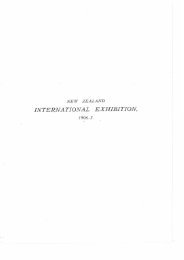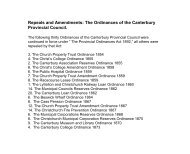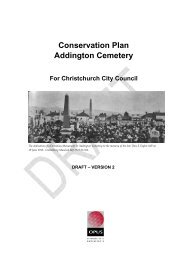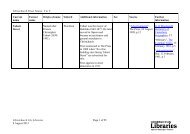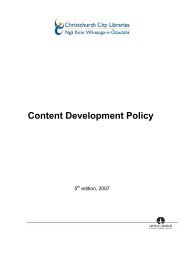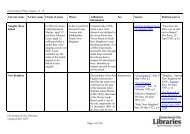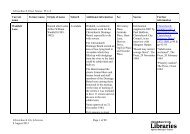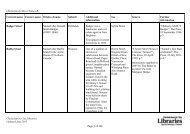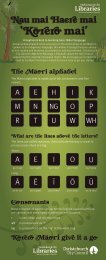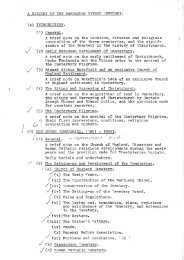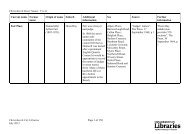Puawaitanga o te Ringa - Christchurch City Libraries
Puawaitanga o te Ringa - Christchurch City Libraries
Puawaitanga o te Ringa - Christchurch City Libraries
You also want an ePaper? Increase the reach of your titles
YUMPU automatically turns print PDFs into web optimized ePapers that Google loves.
Pätiki Pätiki<br />
Pätiki<br />
Pätiki or pätikitiki (flounder) designs are based on the lozenge or diamond shape of the<br />
flounder fish. They can be qui<strong>te</strong> varied within the basic shape. According to Ngäti Porou<br />
tradition, the pätikitiki significance rela<strong>te</strong>s to being able to provide 100% - not only for the<br />
husband, or the whänau, but for the whole iwi. It acknowledges the fact that women were<br />
always looking for ways to supplement their food supplies, even in the dark when the<br />
flounders came, while their men were sound asleep.<br />
Poutama<br />
Poutama<br />
The pillar shows three in<strong>te</strong>rpretations of the s<strong>te</strong>pped poutama pat<strong>te</strong>rn, signifying the growth<br />
of man, striving ever upwards. In meeting houses, the panels are usually mirror imaged so<br />
that the s<strong>te</strong>ps climb upwards from both sides to reach the summit at the centre. The<br />
porourangi variation is af<strong>te</strong>r that crea<strong>te</strong>d by Sir Apirana Ngata for his home at Waiomatatini.<br />
Waharua<br />
Waharua<br />
In the Urewera, the waharua is sometimes known as double mouth but on the East Coast<br />
its name is whakarua kopito, which alludes to deepening the position of the pito or navel.<br />
Its significance rela<strong>te</strong>s to the bravery of warriors, indicating that if they are to be wounded<br />
by an enemy it should be in the area of the navel so that when they return home their<br />
people can seen that they were facing the enemy when struck.<br />
Purapura Purapura Whetu<br />
Whetu<br />
Purapura whetu (star seeds, or sometimes, star dust) is the Arawa name for a simple crossstitch<br />
pat<strong>te</strong>rn that used to be known as pukanohi (herring’s eyes) on the East Coast, and<br />
kowhiti (to cross) in the Whanganui region. Another form, possibly older, with every space<br />
filled with a cross stitch is an Arawa version called Te Mangoroa (the long shark, being the<br />
Milky Way). Hiroa said the Whanganui elders believed this was one of the few original<br />
designs, but the pat<strong>te</strong>rned was abandoned because it was monotonous and the name lost.<br />
The <strong>te</strong>rm kowhiti was applied to the allover design when al<strong>te</strong>rna<strong>te</strong> light and dark coloured<br />
stitches, crea<strong>te</strong>d an open effect. This form was also known in some regions as roimata<br />
<strong>te</strong>ars. One traditional meaning of this pat<strong>te</strong>rn is that to survive as an iwi, a häpu, a whänau,<br />
you must have numbers, just as the stars of the Milk Way, otherwise you may be wiped out.<br />
Mumu<br />
Mumu<br />
The mumu alludes to the style of panel which the Whanganui iwi divided into rows of three<br />
elonga<strong>te</strong>d blocks. The resultant areas are filled with similar types of pat<strong>te</strong>rn. In this example,<br />
the central section is filled with a version of waharua. The four corners are filled with single<br />
stitch pat<strong>te</strong>rns, based on traditional bird footprint designs. The horizontal or vertical chevrons<br />
were identified on the East Coast as tapuae kautuku (bit<strong>te</strong>rn’s footprints) and waewae<br />
pakura (swamp hen’s feet).<br />
Ngä Ngä Heke Heke Iho Iho<br />
Iho<br />
The name of this panel, Ngä Heke Iho, alludes to the falling of women’s <strong>te</strong>ars, in remembrance<br />
of Helen. The panel is in the mumu form, but its pat<strong>te</strong>rns are in<strong>te</strong>nded to show the creativity<br />
that can be achieved by using tukutuku <strong>te</strong>chniques. The central section is filled with Mae’s<br />
Stars, a stitch crea<strong>te</strong>d by tutor Mae Taurua. The corner blocks have versions of the pätiki<br />
form. In the side sections, flowing zigzag lines remind us of the pink braided hair ex<strong>te</strong>nsions<br />
worn by our friend; while the remaining blocks are variations of roimata pat<strong>te</strong>rns.<br />
29



